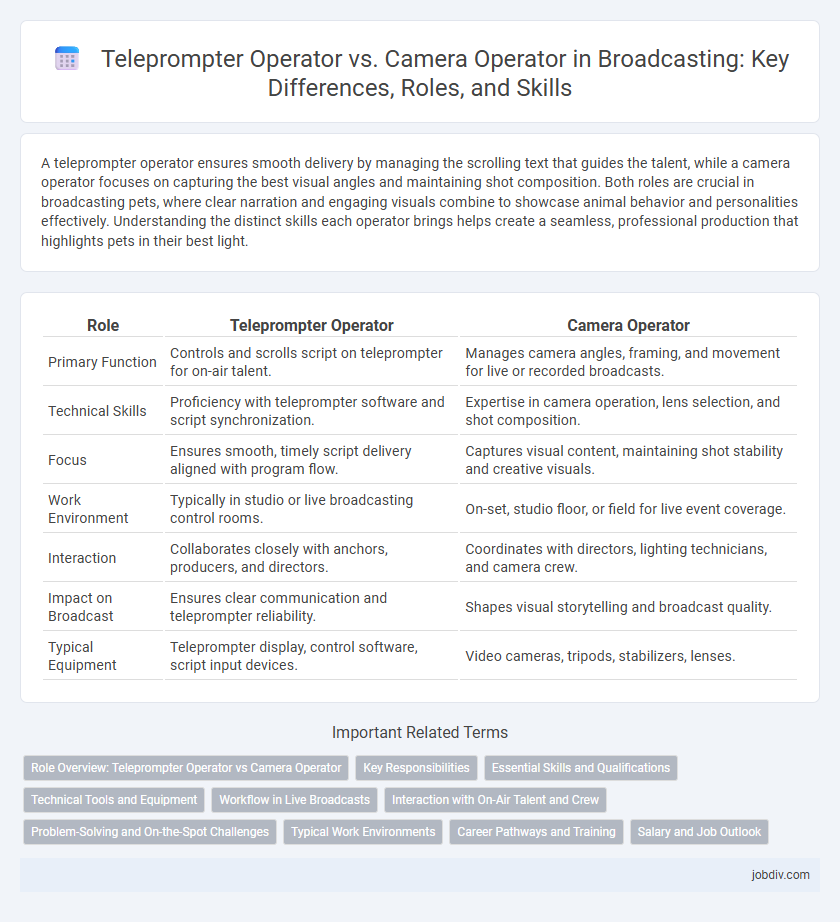A teleprompter operator ensures smooth delivery by managing the scrolling text that guides the talent, while a camera operator focuses on capturing the best visual angles and maintaining shot composition. Both roles are crucial in broadcasting pets, where clear narration and engaging visuals combine to showcase animal behavior and personalities effectively. Understanding the distinct skills each operator brings helps create a seamless, professional production that highlights pets in their best light.
Table of Comparison
| Role | Teleprompter Operator | Camera Operator |
|---|---|---|
| Primary Function | Controls and scrolls script on teleprompter for on-air talent. | Manages camera angles, framing, and movement for live or recorded broadcasts. |
| Technical Skills | Proficiency with teleprompter software and script synchronization. | Expertise in camera operation, lens selection, and shot composition. |
| Focus | Ensures smooth, timely script delivery aligned with program flow. | Captures visual content, maintaining shot stability and creative visuals. |
| Work Environment | Typically in studio or live broadcasting control rooms. | On-set, studio floor, or field for live event coverage. |
| Interaction | Collaborates closely with anchors, producers, and directors. | Coordinates with directors, lighting technicians, and camera crew. |
| Impact on Broadcast | Ensures clear communication and teleprompter reliability. | Shapes visual storytelling and broadcast quality. |
| Typical Equipment | Teleprompter display, control software, script input devices. | Video cameras, tripods, stabilizers, lenses. |
Role Overview: Teleprompter Operator vs Camera Operator
Teleprompter operators manage on-screen text to ensure seamless and precise script delivery during live broadcasts, requiring expertise in synchronizing scrolling speed with presenter pacing. Camera operators handle the technical operation of cameras, framing shots and adjusting focus and angles to capture dynamic visuals that align with the director's vision. Both roles are critical in live production, with teleprompter operators enhancing presenter performance and camera operators driving visual storytelling.
Key Responsibilities
Teleprompter operators ensure seamless script delivery by managing the scrolling text in real-time according to the presenter's pace during live broadcasts. Camera operators control camera movements, framing, and focus to capture high-quality visuals that align with the director's vision. Both roles require technical proficiency and precise coordination to maintain the broadcast's overall production quality.
Essential Skills and Qualifications
Teleprompter operators must excel in reading speed, precision, and timing to ensure seamless script delivery during live broadcasts, requiring strong concentration and familiarity with teleprompting software. Camera operators need expertise in framing, focus, and movement, along with technical knowledge of camera equipment and video production techniques to capture high-quality footage. Both roles demand excellent communication skills, adaptability to dynamic production environments, and the ability to collaborate effectively with directors and on-air talent.
Technical Tools and Equipment
Teleprompter operators utilize specialized software and hardware, including monitors and scrolling text control systems, to ensure seamless script delivery during live broadcasts. Camera operators rely on advanced cameras, stabilizers, lenses, and remote control equipment to capture high-quality video footage from multiple angles. Both roles require proficiency in synchronizing their technical tools to maintain broadcast fluidity and visual coherence.
Workflow in Live Broadcasts
Teleprompter operators ensure seamless script delivery by synchronizing text speed with the speaker's pace, enhancing real-time communication during live broadcasts. Camera operators manage shot composition and movement, capturing dynamic visuals that align with the director's vision and live event flow. Coordination between teleprompter operators and camera operators is critical for maintaining broadcast timing, ensuring smooth transitions, and delivering a polished viewer experience.
Interaction with On-Air Talent and Crew
Teleprompter operators maintain seamless communication with on-air talent by adjusting script speed and flow to match the speaker's pace, enhancing broadcast fluidity. Camera operators coordinate closely with directors and on-air talent to capture precise angles and movements, ensuring visual storytelling aligns with the production's narrative. Both roles require real-time interaction and adaptability to maintain synchronization between talent delivery and technical execution.
Problem-Solving and On-the-Spot Challenges
Teleprompter operators excel at quickly adjusting script speeds and resolving technical glitches to maintain smooth on-air delivery, directly impacting broadcast flow. Camera operators handle dynamic framing, lighting changes, and unexpected movements, requiring rapid decision-making to capture optimal shots under pressure. Both roles demand real-time problem-solving skills but differ in technical focus and immediate operational challenges during live broadcasts.
Typical Work Environments
Teleprompter operators typically work in studio settings or live broadcast environments, focusing on controlling the script display for on-air talent. Camera operators often operate in diverse locations including studios, outdoor scenes, and event venues, managing shot composition and camera movement. Both roles require collaboration within production teams, but camera operators face more dynamic work environments due to changing shot requirements and locations.
Career Pathways and Training
Teleprompter operators typically undergo specialized training in script management, timing, and communication skills, often starting with roles in production assistance before advancing to live broadcast positions. Camera operators focus on mastering equipment operation, shot composition, and technical camera skills through formal education or on-the-job training, frequently progressing from assistant camera roles to lead operator jobs. Both career pathways benefit from hands-on experience and certifications in broadcast technology to advance in the competitive media industry.
Salary and Job Outlook
Teleprompter operators typically earn a median salary of around $45,000 per year, with demand driven by live broadcasting and news production sectors. Camera operators have a broader salary range, often between $40,000 and $70,000 annually, influenced by experience and industry specialization such as film, television, or event coverage. Job outlook for camera operators is expected to grow faster than average due to increasing content production, while teleprompter operators face more stable but limited opportunities tied closely to live news and studio settings.
Teleprompter Operator vs Camera Operator Infographic

 jobdiv.com
jobdiv.com